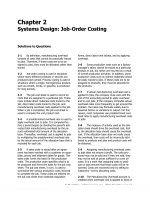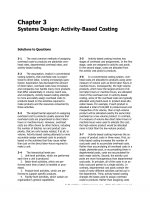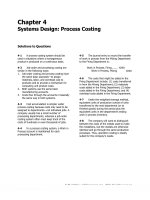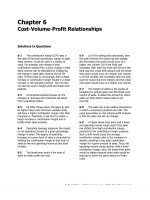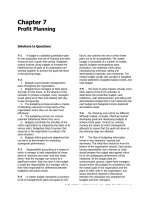Solution manual introduction managerial accounting 5e by garrison chapter 09
Bạn đang xem bản rút gọn của tài liệu. Xem và tải ngay bản đầy đủ của tài liệu tại đây (1.37 MB, 75 trang )
To download more slides, ebook, solutions and test bank, visit
Chapter 09 - Standard Costs
Chapter 9
Standard Costs
Solutions to Questions
9-1
A quantity standard indicates how much
of an input should be used to make a unit of
output. A price standard indicates how much the
input should cost.
9-7
This combination of variances may
indicate that inferior quality materials were
purchased at a discounted price, but the lowquality materials created production problems.
9-2
Ideal standards assume perfection and
do not allow for any inefficiency. Ideal standards
are rarely, if ever, attained. Practical standards
can be attained by employees working at a
reasonable, though efficient pace and allow for
normal breaks and work interruptions.
9-8
If standards are used to find who to
blame for problems, they can breed resentment
and undermine morale. Standards should not be
used to find someone to blame for problems.
9-9
Several factors other than the
contractual rate paid to workers can cause a
labor rate variance. For example, skilled workers
with high hourly rates of pay can be given duties
that require little skill and that call for low hourly
rates of pay, resulting in an unfavorable rate
variance. Or unskilled or untrained workers can
be assigned to tasks that should be filled by
more skilled workers with higher rates of pay,
resulting in a favorable rate variance.
Unfavorable rate variances can also arise from
overtime work at premium rates.
9-3
Under management by exception,
managers focus their attention on results that
deviate from expectations. It is assumed that
results that meet expectations do not require
investigation.
9-4
Separating an overall variance into a
price variance and a quantity variance provides
more information. Moreover, price and quantity
variances are usually the responsibilities of
different managers.
9-10 If poor quality materials create
production problems, a result could be excessive
labor time and therefore an unfavorable labor
efficiency variance. Poor quality materials would
not ordinarily affect the labor rate variance.
9-5
The materials price variance is usually
the responsibility of the purchasing manager.
The materials quantity and labor efficiency
variances are usually the responsibility of
production managers and supervisors.
9-11 If overhead is applied on the basis of
direct labor-hours, then the variable overhead
efficiency variance and the direct labor
efficiency variance will always be favorable or
unfavorable together. Both variances are
computed by comparing the number of direct
labor-hours actually worked to the standard
hours allowed. That is, in each case the formula
is:
9-6
The materials price variance can be
computed either when materials are purchased
or when they are placed into production. It is
usually better to compute the variance when
materials are purchased because that is when
the purchasing manager, who has responsibility
for this variance, has completed his or her work.
In addition, recognizing the price variance when
materials are purchased allows the company to
carry its raw materials in the inventory accounts
at standard cost, which greatly simplifies
bookkeeping.
Efficiency Variance = SR(AH – SH)
Only the ―SR‖ part of the formula, the standard
rate, differs between the two variances.
9-1
To download more slides, ebook, solutions and test bank, visit
Chapter 09 - Standard Costs
9-12 A statistical control chart is a graphical
aid that helps identify variances that should be
investigated. Upper and lower limits are set on
the control chart. Any variances falling between
those limits are considered to be normal. Any
variances falling outside of those limits are
considered abnormal and are investigated.
output of the entire system is limited by the
capacity of the bottleneck. If workstations
before the bottleneck in the production process
produce at capacity, the bottleneck will be
unable to process all of the work in process. In
general, if every workstation is attempting to
produce at capacity, then work in process
inventory will build up in front of the
workstations with the least capacity.
9-13 If labor is a fixed cost and standards are
tight, then the only way to generate favorable
labor efficiency variances is for every
workstation to produce at capacity. However, the
9-2
To download more slides, ebook, solutions and test bank, visit
Chapter 09 - Standard Costs
Brief Exercise 9-1 (20 minutes)
1. Cost per 15-gallon container ................................
Less 2% cash discount ........................................
Net cost ..............................................................
Add shipping cost per container ($130 ÷ 100) ......
Total cost per 15-gallon container (a) ...................
Number of quarts per container
(15 gallons × 4 quarts per gallon) (b) ................
Standard cost per quart purchased (a) ÷ (b) .........
2. Content per bill of materials .............................
Add allowance for evaporation and spillage
(7.6 quarts ÷ 0.95 = 8.0 quarts;
8.0 quarts – 7.6 quarts = 0.4 quarts) ............
Total ...............................................................
Add allowance for rejected units
(8.0 quarts ÷ 40 bottles) ...............................
Standard quantity per salable bottle of solvent ..
3.
Item
Echol
Standard
Quantity
8.2 quarts
Standard Price
$1.90 per quart
9-3
$115.00
2.30
112.70
1.30
$114.00
60
$1.90
7.6 quarts
0.4 quarts
8.0 quarts
0.2 quarts
8.2 quarts
Standard Cost
per Bottle
$15.58
To download more slides, ebook, solutions and test bank, visit
Chapter 09 - Standard Costs
Brief Exercise 9-2 (20 minutes)
1.
Number of helmets ...........................................
Standard kilograms of plastic per helmet ............
Total standard kilograms allowed .......................
Standard cost per kilogram ................................
Total standard cost ...........................................
35,000
× 0.6
21,000
× RM8
RM168,000
Actual cost incurred (given) ...............................
Total standard cost (above) ...............................
Total material variance—unfavorable..................
RM171,000
168,000
RM 3,000
2. Actual Quantity
of Input, at
Actual Price
(AQ × AP)
RM171,000
Actual Quantity of Input,
at Standard Price
(AQ × SP)
22,500 kilograms ×
RM8 per kilogram
= RM180,000
Standard Quantity
Allowed for Output, at
Standard Price
(SQ × SP)
21,000 kilograms* ×
RM8 per kilogram
= RM168,000
Price Variance,
Quantity Variance,
RM9,000 F
RM12,000 U
Total Variance,
RM3,000 U
*35,000 helmets × 0.6 kilograms per helmet = 21,000 kilograms
Alternatively, the variances can be computed using the formulas:
Materials price variance = AQ (AP – SP)
22,500 kilograms (RM7.60 per kilogram* – RM8.00 per kilogram)
= RM9,000 F
* RM171,000 ÷ 22,500 kilograms = RM7.60 per kilogram
Materials quantity variance = SP (AQ – SQ)
RM8 per kilogram (22,500 kilograms – 21,000 kilograms)
= RM12,000 U
9-4
To download more slides, ebook, solutions and test bank, visit
Chapter 09 - Standard Costs
Brief Exercise 9-3 (20 minutes)
1. Number of meals prepared ...................
Standard direct labor-hours per meal ....
Total direct labor-hours allowed ............
Standard direct labor cost per hour .......
Total standard direct labor cost .............
4,000
× 0.25
1,000
× $9.75
$9,750
Actual cost incurred..............................
Total standard direct labor cost (above)
Total direct labor variance ....................
2.
Actual Hours of
Input, at the
Actual Rate
(AH × AR)
960 hours ×
$10.00 per hour
= $9,600
Actual Hours of Input,
at the Standard Rate
(AH × SR)
960 hours ×
$9.75 per hour
= $9,360
$9,600
9,750
$ 150 Favorable
Standard Hours
Allowed for Output, at
the Standard Rate
(SH × SR)
1,000 hours ×
$9.75 per hour
= $9,750
Rate Variance,
Efficiency Variance,
$240 U
$390 F
Total Variance,
$150 F
Alternatively, the variances can be computed using the formulas:
Labor rate variance = AH(AR – SR)
= 960 hours ($10.00 per hour – $9.75 per hour)
= $240 U
Labor efficiency variance = SR(AH – SH)
= $9.75 per hour (960 hours – 1,000 hours)
= $390 F
9-5
To download more slides, ebook, solutions and test bank, visit
Chapter 09 - Standard Costs
Brief Exercise 9-4 (20 minutes)
1. Number of items shipped .................................
Standard direct labor-hours per item ................
Total direct labor-hours allowed .......................
Standard variable overhead cost per hour .........
Total standard variable overhead cost ..............
Actual variable overhead cost incurred .............
Total standard variable overhead cost (above) ..
Total variable overhead variance ......................
2.
Actual Hours of
Input, at the
Actual Rate
(AH × AR)
2,300 hours ×
$3.20 per hour*
= $7,360
Actual Hours of Input,
at the Standard Rate
(AH × SR)
2,300 hours ×
$3.25 per hour
= $7,475
120,000
× 0.02
2,400
× $3.25
$ 7,800
$7,360
7,800
$ 440 Favorable
Standard Hours
Allowed for Output, at
the Standard Rate
(SH × SR)
2,400 hours ×
$3.25 per hour
= $7,800
Variable Overhead Rate
Variance, $115 F
Variable Overhead
Efficiency Variance,
$325 F
Total Variance,
$440 F
*$7,360 ÷ 2,300 hours = $3.20 per hour
Alternatively, the variances can be computed using the formulas:
Variable overhead rate variance:
AH(AR – SR) = 2,300 hours ($3.20 per hour – $3.25 per hour)
= $115 F
Variable overhead efficiency variance:
SR(AH – SH) = $3.25 per hour (2,300 hours – 2,400 hours)
= $325 F
9-6
To download more slides, ebook, solutions and test bank, visit
Chapter 09 - Standard Costs
Exercise 9-5 (20 minutes)
1. The standard price of a kilogram of white chocolate is determined as
follows:
Purchase price, finest grade white chocolate ........................
Less purchase discount, 8% of the purchase price of £7.50 ..
Shipping cost from the supplier in Belgium...........................
Receiving and handling cost ................................................
Standard price per kilogram of white chocolate ....................
£7.50
(0.60)
0.30
0.04
£7.24
2. The standard quantity, in kilograms, of white chocolate in a dozen
truffles is computed as follows:
Material requirements .............................
Allowance for waste ...............................
Allowance for rejects ..............................
Standard quantity of white chocolate .......
0.70
0.03
0.02
0.75
3. The standard cost of the white chocolate in a dozen truffles is
determined as follows:
Standard quantity of white chocolate (a) .....
Standard price of white chocolate (b) ..........
Standard cost of white chocolate (a) × (b) ..
9-7
0.75 kilogram
£7.24 per kilogram
£5.43
To download more slides, ebook, solutions and test bank, visit
Chapter 09 - Standard Costs
Exercise 9-6 (30 minutes)
1. a. Notice in the solution below that the materials price variance is
computed on the entire amount of materials purchased, whereas the
materials quantity variance is computed only on the amount of
materials used in production.
Actual Quantity
of Input, at
Actual Price
(AQ × AP)
25,000 microns ×
$0.48 per micron
= $12,000
Actual Quantity of
Input, at Standard Price
(AQ × SP)
25,000 microns ×
$0.50 per micron
= $12,500
Standard Quantity
Allowed for Output, at
Standard Price
(SQ × SP)
18,000 microns* ×
$0.50 per micron
= $9,000
Price Variance,
$500 F
20,000 microns × $0.50 per micron
= $10,000
Quantity Variance,
$1,000 U
*3,000 toys × 6 microns per toy = 18,000 microns
Alternatively, the variances can be computed using the formulas:
Materials price variance = AQ (AP – SP)
25,000 microns ($0.48 per micron – $0.50 per micron) = $500 F
Materials quantity variance = SP (AQ – SQ)
$0.50 per micron (20,000 microns – 18,000 microns) = $1,000 U
9-8
To download more slides, ebook, solutions and test bank, visit
Chapter 09 - Standard Costs
Exercise 9-6 (continued)
b. Direct labor variances:
Actual Hours of
Input, at the
Actual Rate
(AH × AR)
$36,000
Actual Hours of Input,
at the Standard Rate
(AH × SR)
4,000 hours ×
$8.00 per hour
= $32,000
Standard Hours Allowed
for Output, at the
Standard Rate
(SH × SR)
3,900 hours* ×
$8.00 per hour
= $31,200
Rate Variance,
Efficiency Variance,
$4,000 U
$800 U
Total Variance,
$4,800 U
*3,000 toys × 1.3 hours per toy = 3,900 hours
Alternatively, the variances can be computed using the formulas:
Labor rate variance = AH (AR – SR)
4,000 hours ($9.00 per hour* – $8.00 per hour) = $4,000 U
*$36,000 ÷ 4,000 hours = $9.00 per hour
Labor efficiency variance = SR (AH – SH)
$8.00 per hour (4,000 hours – 3,900 hours) = $800 U
9-9
To download more slides, ebook, solutions and test bank, visit
Chapter 09 - Standard Costs
Exercise 9-6 (continued)
2. A variance usually has many possible explanations. In particular, we
should always keep in mind that the standards themselves may be
incorrect. Some of the other possible explanations for the variances
observed at Dawson Toys appear below:
Materials Price Variance Since this variance is favorable, the actual price
paid per unit for the material was less than the standard price. This could
occur for a variety of reasons including the purchase of a lower grade
material at a discount, buying in an unusually large quantity to take
advantage of quantity discounts, a change in the market price of the
material, or particularly sharp bargaining by the purchasing department.
Materials Quantity Variance Since this variance is unfavorable, more
materials were used to produce the actual output than were called for by
the standard. This could also occur for a variety of reasons. Some of the
possibilities include poorly trained or supervised workers, improperly
adjusted machines, and defective materials.
Labor Rate Variance Since this variance is unfavorable, the actual
average wage rate was higher than the standard wage rate. Some of the
possible explanations include an increase in wages that has not been
reflected in the standards, unanticipated overtime, and a shift toward
more highly paid workers.
Labor Efficiency Variance Since this variance is unfavorable, the actual
number of labor hours was greater than the standard labor hours allowed
for the actual output. As with the other variances, this variance could have
been caused by any of a number of factors. Some of the possible
explanations include poor supervision, poorly trained workers, low-quality
materials requiring more labor time to process, and machine breakdowns.
In addition, if the direct labor force is essentially fixed, an unfavorable
labor efficiency variance could be caused by a reduction in output due to
decreased demand for the company’s products.
It is worth noting that all of these variances could have been caused by
the purchase of low quality materials at a cut-rate price.
9-10
To download more slides, ebook, solutions and test bank, visit
Chapter 09 - Standard Costs
Exercise 9-7 (20 minutes)
1.
Actual Quantity
of Input, at
Actual Price
(AQ × AP)
20,000 pounds ×
$2.35 per pound
= $47,000
Actual Quantity
of Input, at
Standard Price
(AQ × SP)
20,000 pounds ×
$2.50 per pound
= $50,000
Standard Quantity
Allowed for Output,
at Standard Price
(SQ × SP)
18,400 pounds* ×
$2.50 per pound
= $46,000
Price Variance,
Quantity Variance,
$3,000 F
$4,000 U
Total Variance,
$1,000 U
*4,000 units × 4.6 pounds per unit = 18,400 pounds
Alternatively, the variances can be computed using the formulas:
Materials price variance = AQ (AP – SP)
20,000 pounds ($2.35 per pound – $2.50 per pound) = $3,000 F
Materials quantity variance = SP (AQ – SQ)
$2.50 per pound (20,000 pounds – 18,400 pounds) = $4,000 U
9-11
To download more slides, ebook, solutions and test bank, visit
Chapter 09 - Standard Costs
Exercise 9-7 (continued)
2.
Actual Hours of
Input, at the
Actual Rate
(AH × AR)
$10,425
Actual Hours of Input,
at the Standard Rate
(AH × SR)
750 hours ×
$12.00 per hour
= $9,000
Standard Hours
Allowed for Output, at
the Standard Rate
(SH × SR)
800 hours* ×
$12.00 per hour
= $9,600
Rate Variance,
Efficiency Variance,
$1,425 U
$600 F
Total Variance,
$825 U
*4,000 units × 0.2 hours per unit = 800 hours
Alternatively, the variances can be computed using the formulas:
Labor rate variance = AH (AR – SR)
750 hours ($13.90 per hour* – $12.00 per hour) = $1,425 U
*10,425 ÷ 750 hours = $13.90 per hour
Labor efficiency variance = SR (AH – SH)
$12.00 per hour (750 hours – 800 hours) = $600 F
9-12
To download more slides, ebook, solutions and test bank, visit
Chapter 09 - Standard Costs
Exercise 9-8 (15 minutes)
Notice in the solution below that the materials price variance is
computed for the entire amount of materials purchased, whereas the
materials quantity variance is computed only for the amount of materials
used in production.
Actual Quantity of
Input, at Actual Price
(AQ × AP)
20,000 pounds ×
$2.35 per pound
= $47,000
Actual Quantity
of Input, at
Standard Price
(AQ × SP)
20,000 pounds ×
$2.50 per pound
= $50,000
Standard Quantity
Allowed for Output,
at Standard Price
(SQ × SP)
13,800 pounds* ×
$2.50 per pound
= $34,500
Price Variance,
$3,000 F
14,750 pounds × $2.50 per pound = $36,875
Quantity Variance,
$2,375 U
*3,000 units × 4.6 pounds per unit = 13,800 pounds
Alternatively, the variances can be computed using the formulas:
Materials price variance = AQ (AP – SP)
20,000 pounds ($2.35 per pound – $2.50 per pound) = $3,000 F
Materials quantity variance = SP (AQ – SQ)
$2.50 per pound (14,750 pounds – 13,800 pounds) = $2,375 U
9-13
To download more slides, ebook, solutions and test bank, visit
Chapter 09 - Standard Costs
Exercise 9-9 (30 minutes)
1. Number of units manufactured .............................
Standard labor time per unit
(18 minutes ÷ 60 minutes per hour) ..................
Total standard hours of labor time allowed ............
Standard direct labor rate per hour.......................
Total standard direct labor cost ............................
× 0.3
6,000
× $12
$72,000
Actual direct labor cost ........................................
Standard direct labor cost ....................................
Total variance—unfavorable .................................
$73,600
72,000
$ 1,600
2.
Actual Hours of
Input, at the
Actual Rate
(AH × AR)
$73,600
Actual Hours of Input,
at the Standard Rate
(AH × SR)
5,750 hours ×
$12.00 per hour
= $69,000
20,000
Standard Hours Allowed
for Output, at the
Standard Rate
(SH × SR)
6,000 hours* ×
$12.00 per hour
= $72,000
Rate Variance,
Efficiency Variance,
$4,600 U
$3,000 F
Total Variance,
$1,600 U
*20,000 units × 0.3 hours per unit = 6,000 hours
Alternatively, the variances can be computed using the formulas:
Labor rate variance = AH (AR – SR)
5,750 hours ($12.80 per hour* – $12.00 per hour) = $4,600 U
*$73,600 ÷ 5,750 hours = $12.80 per hour
Labor efficiency variance = SR (AH – SH)
$12.00 per hour (5,750 hours – 6,000 hours) = $3,000 F
9-14
To download more slides, ebook, solutions and test bank, visit
Chapter 09 - Standard Costs
Exercise 9-9 (continued)
3.
Actual Hours of
Input, at the
Actual Rate
(AH × AR)
$21,850
Actual Hours of Input,
at the Standard Rate
(AH × SR)
5,750 hours ×
$4.00 per hour
= $23,000
Standard Hours
Allowed for Output, at
the Standard Rate
(SH × SR)
6,000 hours ×
$4.00 per hour
= $24,000
Rate Variance,
Efficiency Variance,
$1,150 F
$1,000 F
Total Variance,
$2,150 F
Alternatively, the variances can be computed using the formulas:
Variable overhead rate variance = AH (AR – SR)
5,750 hours ($3.80 per hour* – $4.00 per hour) = $1,150 F
*$21,850 ÷ 5,750 hours = $3.80 per hour
Variable overhead efficiency variance = SR (AH – SH)
$4.00 per hour (5,750 hours – 6,000 hours) = $1,000 F
9-15
To download more slides, ebook, solutions and test bank, visit
Chapter 09 - Standard Costs
Exercise 9-10 (20 minutes)
1. If the total variance is $93 unfavorable, and the rate variance is $87
favorable, then the efficiency variance must be $180 unfavorable,
because the rate and efficiency variances taken together always equal
the total variance. Knowing that the efficiency variance is $180
unfavorable, one approach to the solution would be:
Efficiency variance = SR (AH – SH)
$9.00 per hour (AH – 125 hours*) = $180 U
$9.00 per hour × AH – $1,125 = $180**
$9.00 per hour × AH = $1,305
AH = $1,305 ÷ $9.00 per hour
AH = 145 hours
*50 jobs × 2.5 hours per job = 125 hours
**When used with the formula, unfavorable variances are positive and
favorable variances are negative.
2.
Rate variance = AH (AR – SR)
145 hours (AR – $9.00 per hour) = $87 F
145 hours × AR – $1,305 = –$87*
145 hours × AR = $1,218
AR = $1,218 ÷ 145 hours
AR = $8.40 per hour
*When used with the formula, unfavorable variances are positive and
favorable variances are negative.
9-16
To download more slides, ebook, solutions and test bank, visit
Chapter 09 - Standard Costs
Exercise 9-10 (continued)
An alternative approach would be to work from known to unknown data
in the columnar model for variance analysis:
Actual Hours of Input,
at the Actual Rate
(AH × AR)
145 hours ×
$8.40 per hour
= $1,218
Actual Hours of Input,
at the Standard Rate
(AH × SR)
145 hours ×
$9.00 per hour*
= $1,305
Standard Hours
Allowed for Output, at
the Standard Rate
(SH × SR)
125 hours§ ×
$9.00 per hour*
= $1,125
Rate Variance,
Efficiency Variance,
$87 F*
$180 U
Total Variance,
$93 U*
§
50 tune-ups* × 2.5 hours per tune-up* = 125 hours
*Given
9-17
To download more slides, ebook, solutions and test bank, visit
Chapter 09 - Standard Costs
Problem 9-11A (45 minutes)
1. a. In the solution below, the materials price variance is computed on the
entire amount of materials purchased whereas the materials quantity
variance is computed only on the amount of materials used in
production:
Actual Quantity of
Input, at
Actual Price
(AQ × AP)
$225,000
Actual Quantity
of Input, at
Standard Price
(AQ × SP)
12,000 ounces ×
$20.00 per ounce
= $240,000
Standard Quantity
Allowed for Output, at
Standard Price
(SQ × SP)
9,375 ounces* ×
$20.00 per ounce
= $187,500
Price Variance,
$15,000 F
9,500 ounces × $20.00 per ounce
= $190,000
Quantity Variance,
$2,500 U
*3,750 units × 2.5 ounces per unit = 9,375 ounces
Alternatively, the variances can be computed using the formulas:
Materials price variance = AQ (AP – SP)
12,000 ounces ($18.75 per ounce* – $20.00 per ounce) = $15,000 F
*$225,000 ÷ 12,000 ounces = $18.75 per ounce
Materials quantity variance = SP (AQ – SQ)
$20.00 per ounce (9,500 ounces – 9,375 ounces) = $2,500 U
b. Yes, the contract probably should be signed. The new price of $18.75
per ounce is substantially lower than the old price of $20.00 per
ounce, resulting in a favorable price variance of $15,000 for the
month. Moreover, the material from the new supplier appears to
cause little or no problem in production as shown by the small
materials quantity variance for the month.
9-18
To download more slides, ebook, solutions and test bank, visit
Chapter 09 - Standard Costs
Problem 9-11A (continued)
2. a.
Actual Hours of
Input, at the
Actual Rate
(AH × AR)
5,600 hours* ×
$12.00 per hour
= $67,200
Actual Hours of
Input, at the
Standard Rate
(AH × SR)
5,600 hours ×
$12.50 per hour
= $70,000
Standard Hours
Allowed for Output, at
the Standard Rate
(SH × SR)
5,250 hours** ×
$12.50 per hour
= $65,625
Rate Variance,
Efficiency Variance,
$2,800 F
$4,375 U
Total Variance,
$1,575 U
* 35 technicians × 160 hours per technician = 5,600 hours
** 3,750 units × 1.4 hours per technician = 5,250 hrs
Alternatively, the variances can be computed using the formulas:
Labor rate variance = AH (AR – SR)
5,600 hours ($12.00 per hour – $12.50 per hour) = $2,800 F
Labor efficiency variance = SR (AH – SH)
$12.50 per hour (5,600 hours – 5,250 hours) = $4,375 U
b. No, the new labor mix probably should not be continued. Although it
decreases the average hourly labor cost from $12.50 to $12.00,
thereby causing a $2,800 favorable labor rate variance, this savings is
more than offset by a large unfavorable labor efficiency variance for
the month. Thus, the new labor mix increases overall labor costs.
9-19
To download more slides, ebook, solutions and test bank, visit
Chapter 09 - Standard Costs
Problem 9-11A (continued)
3.
Actual Hours of
Input, at the
Actual Rate
(AH × AR)
$18,200
Actual Hours of
Input, at the
Standard Rate
(AH × SR)
5,600 hours* ×
$3.50 per hour
= $19,600
Standard Hours
Allowed for Output,
at the Standard Rate
(SH × SR)
5,250 hours** ×
$3.50 per hour
= $18,375
Rate Variance,
Efficiency Variance,
$1,400 F
$1,225 U
Total Variance,
$175 F
* Based on direct labor hours:
35 technicians × 160 hours per technician = 5,600 hours
** 3,750 units × 1.4 hours per unit = 5,250 hours
Alternatively, the variances can be computed using the formulas:
Variable overhead rate variance = AH (AR – SR)
5,600 hours ($3.25 per hour* – $3.50 per hour) = $1,400 F
*$18,200 ÷ 5,600 hours = $3.25 per hour
Variable overhead efficiency variance = SR (AH – SH)
$3.50 per hour (5,600 hours – 5,250 hours) = $1,225 U
Both the labor efficiency variance and the variable overhead efficiency
variance are computed by comparing actual labor-hours to standard
labor-hours. Thus, if the labor efficiency variance is unfavorable, then
the variable overhead efficiency variance will be unfavorable as well.
9-20
To download more slides, ebook, solutions and test bank, visit
Chapter 09 - Standard Costs
Problem 9-12A (45 minutes)
1. a.
Actual Quantity of
Input, at Actual Price
(AQ × AP)
60,000 pounds ×
$1.95 per pound
= $117,000
Actual Quantity
of Input, at
Standard Price
(AQ × SP)
60,000 pounds ×
$2.00 per pound
= $120,000
Standard Quantity
Allowed for Output,
at Standard Price
(SQ × SP)
45,000 pounds* ×
$2.00 per pound
= $90,000
Price Variance,
$3,000 F
49,200 pounds × $2.00 per pound = $98,400
Quantity Variance,
$8,400 U
*15,000 pools × 3.0 pounds per pool = 45,000 pounds
Alternatively, the variances can be computed using the formulas:
Materials price variance = AQ (AP – SP)
60,000 pounds ($1.95 per pound – $2.00 per pound) = $3,000 F
Materials quantity variance = SP (AQ – SQ)
$2.00 per pound (49,200 pounds – 45,000 pounds) = $8,400 U
9-21
To download more slides, ebook, solutions and test bank, visit
Chapter 09 - Standard Costs
Problem 9-12A (continued)
b.
Actual Hours of
Input, at the
Actual Rate
(AH × AR)
11,800 hours ×
$7.00 per hour
= $82,600
Actual Hours of Input,
at the Standard Rate
(AH × SR)
11,800 hours ×
$6.00 per hour
= $70,800
Standard Hours
Allowed for Output,
at the Standard Rate
(SH × SR)
12,000 hours* ×
$6.00 per hour
= $72,000
Rate Variance,
Efficiency Variance,
$11,800 U
$1,200 F
Total Variance,
$10,600 U
*15,000 pools × 0.8 hours per pool = 12,000 hours
Alternatively, the variances can be computed using the formulas:
Labor rate variance = AH (AR – SR)
11,800 hours ($7.00 per hour – $6.00 per hour) = $11,800 U
Labor efficiency variance = SR (AH – SH)
$6.00 per hour (11,800 hours – 12,000 hours) = $1,200 F
9-22
To download more slides, ebook, solutions and test bank, visit
Chapter 09 - Standard Costs
Problem 9-12A (continued)
c.
Actual Hours of
Input, at the
Actual Rate
(AH × AR)
$18,290
Actual Hours of
Input, at the
Standard Rate
(AH × SR)
5,900 hours ×
$3.00 per hour
= $17,700
Standard Hours
Allowed for Output,
at the Standard Rate
(SH × SR)
6,000 hours* ×
$3.00 per hour
= $18,000
Rate Variance,
Efficiency Variance,
$590 U
$300 F
Total Variance,
$290 U
*15,000 pools × 0.4 hours per pool = 6,000 hours
Alternatively, the variances can be computed using the formulas:
Variable overhead rate variance = AH (AR – SR)
5,900 hours ($3.10 per hour* – $3.00 per hour) = $590 U
*$18,290 ÷ 5,900 hours = $3.10 per hour
Variable overhead efficiency variance = SR (AH – SH)
$3.00 per hour (5,900 hours – 6,000 hours) = $300 F
9-23
To download more slides, ebook, solutions and test bank, visit
Chapter 09 - Standard Costs
Problem 9-12A (continued)
2. Summary of variances:
Material price variance ..........................
Material quantity variance .....................
Labor rate variance ...............................
Labor efficiency variance.......................
Variable overhead rate variance .............
Variable overhead efficiency variance ....
Net variance .........................................
$ 3,000
8,400
11,800
1,200
590
300
$16,290
F
U
U
F
U
F
U
The net unfavorable variance of $16,290 for the month caused the
plant’s variable cost of goods sold to increase from the budgeted level of
$180,000 to $196,290:
Budgeted cost of goods sold at $12 per pool .........
Add the net unfavorable variance, as above ..........
Actual cost of goods sold .....................................
$180,000
16,290
$196,290
This $16,290 net unfavorable variance also accounts for the difference
between the budgeted net operating income and the actual net
operating income for the month.
Budgeted net operating income ............................
Deduct the net unfavorable variance added to cost
of goods sold for the month ..............................
Net operating income ..........................................
$36,000
16,290
$19,710
3. The two most significant variances are the materials quantity variance
and the labor rate variance. Possible causes of the variances include:
Materials quantity variance: Outdated standards, unskilled workers,
poorly adjusted machines,
carelessness, poorly trained workers,
inferior quality materials.
Labor rate variance:
Outdated standards, change in pay
scale, overtime pay.
9-24
To download more slides, ebook, solutions and test bank, visit
Chapter 09 - Standard Costs
Problem 9-13A (45 minutes)
1. The standard quantity of plates allowed for tests performed during the
month would be:
Blood tests ...................................
Smears ........................................
Total ............................................
Plates per test ..............................
Standard quantity allowed.............
1,800
2,400
4,200
× 2
8,400
The variance analysis for plates would be:
Actual Quantity of
Input, at Actual Price
(AQ × AP)
$28,200
Actual Quantity
of Input, at
Standard Price
(AQ × SP)
12,000 plates ×
$2.50 per plate
= $30,000
Standard Quantity
Allowed for Output,
at Standard Price
(SQ × SP)
8,400 plates ×
$2.50 per plate
= $21,000
Price Variance,
$1,800 F
10,500 plates × $2.50 per plate = $26,250
Quantity Variance,
$5,250 U
Alternatively, the variances can be computed using the formulas:
Materials price variance = AQ (AP – SP)
12,000 plates ($2.35 per plate* – $2.50 per plate) = $1,800 F
*$28,200 ÷ 12,000 plates = $2.35 per plate.
Materials quantity variance = SP (AQ – SQ)
$2.50 per plate (10,500 plates – 8,400 plates) = $5,250 U
9-25


